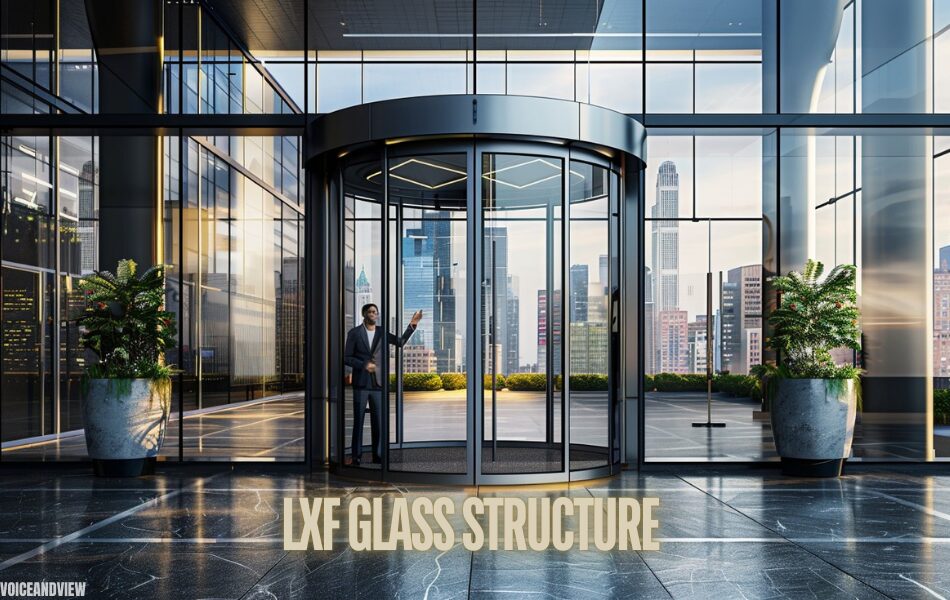Lxf Glass Structure: Master Modern Architecture

Imagine a world where buildings are not just functional structures, but also breathtaking works of art. A world where glass, once fragile and limited, becomes a versatile and durable material, capable of transforming the very essence of architecture. Welcome to the realm of Lxf glass structures, a revolutionary innovation that is redefining the possibilities of modern design.
In this article, we will delve into the fascinating world of Lxf glass structures, exploring their unique properties, applications, and the profound impact they are making on the architectural landscape. From their construction process to their environmental benefits, we will uncover the reasons why Lxf glass is rapidly becoming the material of choice for architects and builders worldwide.
Our journey will begin by unraveling the mysteries of Lxf glass itself, understanding its composition and the remarkable advantages it offers over traditional glass. We will then explore the diverse applications of Lxf glass structures, from residential homes to towering skyscrapers and everything in between. Next, we will delve into the intricacies of constructing Lxf glass structures, from planning and design to installation and maintenance. Finally, we will discuss the environmental implications of Lxf glass, exploring how it contributes to sustainable building practices and a greener future.
Contents
What is Lxf Glass Structure?
Lxf glass structures, a marvel of modern engineering, are architectural elements constructed primarily from laminated glass. This innovative material is composed of multiple layers of glass bonded together with a tough interlayer, typically made of polyvinyl butyral (PVB). The interlayer serves as a crucial component, enhancing the glass’s strength, durability, and safety properties.
The concept of laminated glass dates back to the late 19th century, when the French chemist Edouard Benedictus accidentally discovered its potential. While experimenting with cellulose nitrate, Benedictus dropped a glass flask containing the substance, only to find that the glass shattered but remained intact due to the presence of the nitrate film. This serendipitous discovery paved the way for the development of laminated glass, which was initially used primarily for automotive windshields.
In recent decades, Lxf glass structures have emerged as a popular choice for architects and builders seeking to combine aesthetics with functionality. The versatility of Lxf glass allows for the creation of a wide range of architectural elements, from floor-to-ceiling windows and skylights to structurally sound walls and facades.
Types of Lxf Glass Structures
Lxf glass structures can be categorized into several distinct types, each with its own unique characteristics and applications:
- Laminated Glass Walls: These walls are constructed using multiple layers of laminated glass, offering exceptional strength and durability. They are often used in commercial buildings, such as offices and retail spaces, to create visually striking and energy-efficient interiors.
- Laminated Glass Facades: Lxf glass facades are exterior walls made entirely or partially of laminated glass. They provide a modern and transparent appearance, allowing natural light to flood into the building. Lxf glass facades are commonly found in high-rise buildings, hotels, and museums.
- Laminated Glass Skylights: Skylights made of Lxf glass offer a natural way to illuminate interior spaces while providing excellent insulation. They are available in various sizes and shapes, allowing architects to customize the amount of natural light that enters a building.
- Laminated Glass Floors: Lxf glass floors are a visually stunning and functional architectural element. They offer a unique perspective, allowing occupants to view the spaces below. Lxf glass floors are often used in lobbies, atriums, and residential homes.
- Laminated Glass Staircases: Lxf glass staircases add a touch of elegance and modernity to any space. They can be designed in various styles, from minimalist to ornate, and offer a safe and visually appealing way to connect different levels of a building.
- Laminated Glass Doors: Lxf glass doors provide a transparent and inviting entrance to buildings. Lxf glass structures, a testament to modern engineering, are architectural features built mainly with laminated glass.
These are just a few examples of the many ways in which Lxf glass structures can be incorporated into modern architecture. The versatility of Lxf glass allows for endless possibilities, limited only by the imagination of designers and builders.
Benefits of Lxf Glass Structures
One of the most significant advantages of Lxf glass is its exceptional durability and strength. The laminated construction, with its multiple layers of glass bonded together with a tough interlayer, provides resistance to impact, thermal shock, and other stresses. This makes Lxf glass structures highly resistant to breakage, ensuring long-lasting performance and safety.
Lxf glass structures can contribute significantly to energy efficiency. The interlayer in laminated glass acts as a natural insulator, helping to reduce heat transfer between the interior and exterior of a building. This can lead to lower energy consumption for heating and cooling, resulting in reduced energy bills and a smaller environmental footprint.
Lxf glass offers a wide range of aesthetic possibilities, allowing architects and designers to create visually stunning and innovative structures. The transparency of Lxf glass allows for natural light to flood into buildings, creating a bright and airy atmosphere. Additionally, Lxf glass can be customized with various finishes, such as tints, patterns, or even digital prints, to enhance the overall design and aesthetic appeal.
Lxf glass structures prioritize safety and security. In the event of breakage, the interlayer in laminated glass helps to hold the glass fragments together, minimizing the risk of injury. This makes Lxf glass particularly suitable for applications where safety is paramount, such as schools, hospitals, and public buildings.
Lxf glass structures can contribute to a more sustainable future. The energy efficiency benefits of Lxf glass reduce the overall environmental impact of buildings. Additionally, Lxf glass is often recyclable, making it a more environmentally friendly choice compared to other building materials.
Lxf Glass Structure Construction Process
The construction of an Lxf glass structure begins with careful planning and design. Architects and engineers collaborate to determine the specific requirements and goals of the project. This involves factors such as the building’s function, size, and desired aesthetic.The construction of Lxf glass structures requires a variety of specialized materials and equipment. These include:
Laminated glass panels: The primary building material, consisting of multiple layers of glass bonded together with a PVB interlayer.
Structural supports: These can be made of steel, aluminum, or other suitable materials, and are used to support the Lxf glass panels.
Sealants and adhesives: High-quality sealants and adhesives are used to bond the Lxf glass panels to the structural supports and to create a watertight seal.
Glazing tools: Specialized tools are used for cutting, handling, and installing the Lxf glass panels.
Safety equipment: Proper safety equipment, such as protective gloves, eye protection, and fall protection, is essential for workers involved in the construction process.
The installation and assembly of Lxf glass structures require precision and skill. The structural supports are erected first, providing a solid foundation for the glass panels. The panels are then carefully lifted into place and secured using the appropriate sealants and adhesives. Special techniques may be necessary for larger or more complex structures.
Quality control is crucial throughout the construction process of Lxf glass structures. Regular inspections are conducted to ensure that the materials and workmanship meet the required standards. This includes verifying the dimensions, alignment, and integrity of the glass panels, as well as the proper functioning of any mechanical systems associated with the structure. By maintaining strict quality control, the long-term durability and safety of the Lxf glass structure can be ensured.
Maintenance and Care of Lxf Glass Structures
Regular Cleaning
Proper cleaning and maintenance are essential to preserve the appearance and functionality of Lxf glass structures. Regular cleaning helps to remove dirt, grime, and other contaminants that can accumulate on the glass surfaces. A mild detergent solution and a soft cloth or sponge can be used to clean Lxf glass. Avoid harsh chemicals or abrasive materials that could damage the glass.
Inspections
Regular inspections are crucial to identify and address any potential issues with Lxf glass structures. These inspections should be conducted at least annually, or more frequently if the structure is exposed to harsh environmental conditions or heavy usage. Look for signs of damage, such as cracks, chips, or delamination. If any issues are detected, it is important to seek professional assistance for repair or replacement.
Repair and Replacement
In some cases, damage to Lxf glass structures may require repair or replacement. Minor cracks or chips can often be repaired using specialized glass repair kits. However, for more extensive damage, it is advisable to consult with a professional glazier. They can assess the extent of the damage and recommend the appropriate course of action, which may involve replacing the damaged glass panel.
It is important to address any damage to Lxf glass structures promptly to prevent further deterioration and ensure the safety and functionality of the structure. Regular maintenance and inspections can help to identify and address issues early on, preventing costly repairs or replacements.
Lxf Glass Structures: Real-World Applications
Residential Buildings
Lxf glass structures are increasingly being incorporated into residential architecture, offering a modern and stylish aesthetic. Floor-to-ceiling windows, skylights, and glass walls are popular choices for homeowners seeking to maximize natural light and create a sense of openness. Lxf glass also provides a high level of insulation, helping to reduce energy consumption and improve overall comfort.
Commercial Buildings
In commercial settings, Lxf glass structures are used to create visually striking and functional spaces. Lxf glass facades are a common feature in modern office buildings, hotels, and retail stores. They offer a transparent and inviting appearance, allowing natural light to flood into the interior. Additionally, Lxf glass can be used to create unique architectural features, such as glass atriums or skybridges.
Industrial Facilities
Lxf glass structures also have applications in industrial settings. For example, Lxf glass can be used to construct observation decks, control rooms, or even entire buildings within industrial facilities. The durability and strength of Lxf glass make it suitable for environments with demanding requirements.
Public Spaces
Lxf glass structures can be found in a variety of public spaces, including museums, libraries, and government buildings. They offer a modern and welcoming atmosphere, while also providing natural light and views of the surrounding environment. Lxf glass can also be used to create unique architectural features, such as glass pavilions or bridges.
These are just a few examples of the many ways in which Lxf glass structures are being used in the real world. The versatility and adaptability of Lxf glass make it a popular choice for architects and builders seeking to create innovative and sustainable structures.
Future Trends in Lxf Glass Technology
The field of Lxf glass technology is constantly evolving, with ongoing research and development aimed at further enhancing its properties and applications. Scientists and engineers are exploring new materials and manufacturing techniques to improve the strength, durability, and energy efficiency of Lxf glass structures. Additionally, research is being conducted on the development of self-cleaning coatings and smart glass technologies that can adapt to changing environmental conditions.
As Lxf glass technology continues to advance, new and exciting applications are emerging. One area of particular interest is the use of Lxf glass in sustainable building design. Researchers are exploring the potential of Lxf glass to integrate with renewable energy systems, such as solar panels or wind turbines. Additionally, Lxf glass could be used to create self-sufficient buildings that generate their own energy and minimize their environmental impact.
Another promising area of development is the use of Lxf glass in healthcare facilities. Lxf glass can be used to create sterile and hygienic environments, while also providing natural light and views of the surrounding landscape. Additionally, Lxf glass can be integrated with advanced technologies, such as sensors and monitoring systems, to improve patient care and safety.
As Lxf glass technology continues to evolve, we can expect to see even more innovative and exciting applications in the years to come. The potential of Lxf glass to shape the future of architecture and building design is truly limitless.
Conclusion
Throughout this article, we have explored the fascinating world of Lxf glass structures. We have delved into their definition, history, and various applications, from residential buildings to commercial spaces and public landmarks. We have also discussed the benefits of Lxf glass, including its durability, energy efficiency, aesthetic appeal, safety features, and environmental sustainability.
Lxf glass structures represent a significant advancement in architectural technology. Their versatility, durability, and aesthetic appeal make them a popular choice for architects and builders seeking to create innovative and sustainable structures. As Lxf glass technology continues to evolve, we can expect to see even more exciting applications and advancements in the years to come.
If you are considering incorporating Lxf glass structures into your next project, we encourage you to learn more about the possibilities and benefits that this innovative material offers. Consult with architects, engineers, and glaziers who specialize in Lxf glass to discuss your specific needs and explore the various options available. By choosing Lxf glass, you can create a structure that is not only visually stunning but also durable, energy-efficient, and environmentally friendly.
FAQ’s
Q: What is the structure of silica based glass?
A: Silica-based glass, also known as soda-lime glass, is the most common type of glass used in everyday life. Its structure is primarily composed of silicon dioxide (SiO2), which forms a network of interconnected tetrahedra. Each silicon atom is bonded to four oxygen atoms, creating a three-dimensional lattice structure. This network structure gives silica-based glass its rigidity and transparency.
Q: What is the structure of the glass?
A: The structure of glass is amorphous, meaning it lacks a regular, crystalline arrangement of atoms. Instead, the atoms are arranged in a random, disordered pattern. This amorphous structure is what gives glass its transparency and other unique properties.
Q: What is the molecular structure of bulletproof glass?
A: Bulletproof glass is a type of laminated glass composed of multiple layers of glass bonded together with a tough interlayer, typically made of polyvinyl butyral (PVB). The molecular structure of bulletproof glass is similar to that of regular glass, but the presence of the PVB interlayer provides additional strength and resistance to impact.
Q: What is the structure of flint glass?
A: Flint glass is a type of glass that contains lead oxide (PbO) in addition to silica. The lead oxide replaces some of the sodium oxide in soda-lime glass, resulting in a denser and more refractive material. The structure of flint glass is still primarily composed of silicon dioxide, but the addition of lead oxide alters the properties of the glass, making it more suitable for certain applications, such as optical lenses and glassware.








